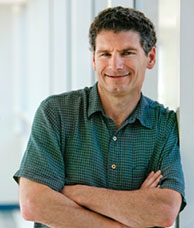2018年7月24日美国Brandeis大学Seth Fraden教授访问功能高分子材料教育部重点实验室,并做了题为“Engineering reaction–diffusion networks with properties of neural tissue”的学术报告。
 Seth Fraden教授 简介:
Seth Fraden教授是国际知名的软物质物理学家,现为美国Brandeis大学物理系资深教授并担任美国自然科学基金会MRSEC项目的Bioinspired Soft Materials Research Science and Engineering Center 的主任。Fraden教授在棒状体系溶致型液晶的实验和理论研究,基于微流控技术的蛋白质大规模结晶以及新兴的交叉学科“活软物质(Active matter)” 方面都有着杰出的贡献,其工作发表在Nature, Science, PRL以及JACS, Lab on Chip等顶级期刊上。曾获得2008年生物结晶国际组织的创新大奖。
报告摘要:
We present an experimental system of networks of coupled non-linear nanoliter-scale chemical reactors containing the Belousov-Zhabotinsky (BZ) reaction, which we theoretically model within a reaction-diffusion framework. Microfluidic fabrication techniques are developed that provide the ability to vary the network topology, the reactor coupling strength and offer the freedom to choose whether an arbitrary reactor is inhibitory or excitatory coupled to its neighbor. This versatile experimental and theoretical framework can be used to create a wide variety of chemical networks. Here we design, construct and characterize chemical networks that achieve the complexity of Central Pattern Generators, which are found in the autonomic nervous system of a variety of organisms. We envision that this artificial nervous system can serve as the controller of a synthetic musculature comprised of chemomechanical gels coupled to the BZ layer in order to create soft robots capable of autonomous activity.
Seth Fraden教授 简介:
Seth Fraden教授是国际知名的软物质物理学家,现为美国Brandeis大学物理系资深教授并担任美国自然科学基金会MRSEC项目的Bioinspired Soft Materials Research Science and Engineering Center 的主任。Fraden教授在棒状体系溶致型液晶的实验和理论研究,基于微流控技术的蛋白质大规模结晶以及新兴的交叉学科“活软物质(Active matter)” 方面都有着杰出的贡献,其工作发表在Nature, Science, PRL以及JACS, Lab on Chip等顶级期刊上。曾获得2008年生物结晶国际组织的创新大奖。
报告摘要:
We present an experimental system of networks of coupled non-linear nanoliter-scale chemical reactors containing the Belousov-Zhabotinsky (BZ) reaction, which we theoretically model within a reaction-diffusion framework. Microfluidic fabrication techniques are developed that provide the ability to vary the network topology, the reactor coupling strength and offer the freedom to choose whether an arbitrary reactor is inhibitory or excitatory coupled to its neighbor. This versatile experimental and theoretical framework can be used to create a wide variety of chemical networks. Here we design, construct and characterize chemical networks that achieve the complexity of Central Pattern Generators, which are found in the autonomic nervous system of a variety of organisms. We envision that this artificial nervous system can serve as the controller of a synthetic musculature comprised of chemomechanical gels coupled to the BZ layer in order to create soft robots capable of autonomous activity.